November 30, 2005
Out of Nowhere
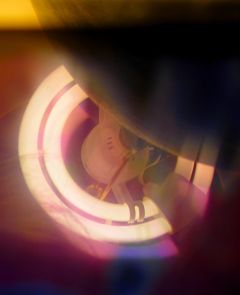
Somewhere in my reading, (I lost the reference, perhaps it was on CurEvents Flu Clinic), I found the suggestion that folks who want to organize on a community level for pandemic preparedness, should begin by forming a group focused on another issue that is not quite as horrifying. When I read that, I realized that I no longer have the energy or the connections to do something like that in my town, but it has manifested anyway.
So here's a little synchronicity story. In preparation for Thanksgiving, those assisting were assigned the rather odious task of clearing the diningroom table. One small piece of the detritus happened to be the town newspaper. My deputy, giving it a quick perusal before disposal, (I never read past the front page anymore, unless there is a particularly juicy piece of gossip that I feel compelled to follow up - remind me to cancel my subscription, read it on line and save trees) revealed a headline on page four "Group Seeks to Make Sustainable Attainable". The leader of said group is a woman bearing my not-too-commonplace maiden name. It was my family name that attracted the peruser to the article in the first place, since he thought "sustainable" was a right wing survivalist term.
I firmly believe that sustainability is the way to go, especially given some of the dreadful possibilities that are looming. I shall send my deputy to the meeting next Tuesday, heavily supplied with bird flu posters should he discover the need for a little sustainability inspiration. Maybe discover a long lost relative in the process -- if she turns out to be a family member, it will be good to have one that's on the right page.
Photo note: This is not an alien invasion. It is a picture of the energy saving florescent bulb in the lamp on my desk -- one of my small gestures toward sustainability so far. I inadvertently shot it while trying to take a picture of the art on my runover cellphone screen. How's that for synchronicity?
On Releasing Resistance
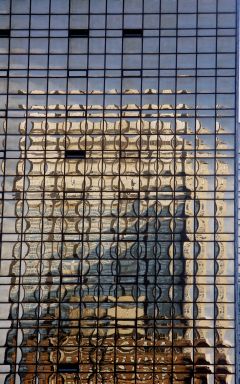
Following the ravages of the tsunami, a team from Harvard and MIT designed The Tsunami Safe(r) House for increased resiliancy. The Boston Globe Magazine reported on November 20, 2005 that "It employs the same number of concrete blocks as a standard Sri Lankan home but instead of using them to build walls, the team has arranged them into stout pillars that form a framework for wooden or bamboo walls. If a tidal wave roars through, the core of the house is more likely to survive. "
When members of the design team visited their prototype last summer, "they learned that the local residents had a far more poetic way to explain the concept. As one Sri Lankan put it: 'You open the door and tell the water: Please enter this way.'"
I, personally, am trying to cultivate the equanimity to go with the flow like that. (You will pardon the expression.).
Photo note: I found myself wondering how this building would fare in a tsunami. Is it already a bit lopsided? Perhaps it's photographer's lean. I do worry about city dwellers in times of disaster, though.
November 28, 2005
The Roots of Spin
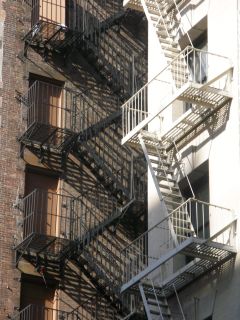
I am sparing you my own, less than profound, musings this morning, because I so very much want everyone to read this clickie in its entirety. It happens to be long. It is always astonishing to me how we must continually relearn the lessons of the past.
Photo note: Metaphorophotographically speaking, this picture has everything -- the up and down, the light and the dark -- everything except the spin, that is --and more and more Dizzy yet?
November 27, 2005
Humanist? Take the Test
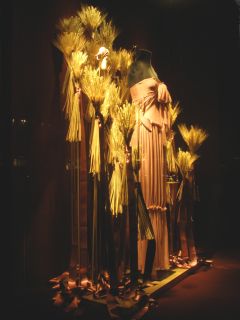
Are you a humanist? If so, have you ever wondered just what flavor you are? Here's the test through which you can make an accurate determination.
It will probably come as no surprize that I am a Haymaker. "You can’t see the point of abstract principles and probably wouldn’t lay down your life for a concept though you might for a friend." Most true. I have actually been working quite hard to become an even better Haymaker recently.
I'd rather be that than a Hardhat, which was the description of the only other person I could convince to take the test. (I might add that it is no small task to convince a Hardhat of anything, let alone taking inaccurate, invalid, unscientific tests) I do know that there is also a "Hairshirt" category -- If you have the patience, and turn out to be some other kind of humanist, please post it in the comments for all of us to enjoy.
Photo note: This is the closest thing to a picture of hay that I had in my collection. What's the difference between wheat and hay anyway? If I were to make a little hay, this is a dress I'd consider wearing You may feel free to think of me swathed in it as I call to the muse. For those who would like to order one, I am sorry to say that I cannot remember the designer window in which I took this picture . Someone famous. I did take it about three days before I took the test - shakey synchronicity, at best.
November 26, 2005
The Practice of Thankfulness -- Illustrated
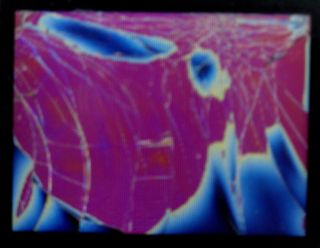
Generally I do not publish what I consider to be art on my blog. I shoot something that someone else has made, and, when I'm lucky, I lay upon it a twist of my own.
This picture is an exception, since I made everything in it from scratch. That is, I produced the subject of the picture with my very own hands, or rather, with my very own car, and now have photographed it for posterity, though not perfectly, since my predawn technical skills need improvement.
It is my way of celebrating the fact that I ran over my cellie yesterday. As I was backing out, I saw it lying on the driveway, looking quite intact. First, I felt the relief of discovery, and thanked god that I hadn't run over it. But on closer examination, I found that I had art, rather than information, on my screen. It still makes and takes calls, for anyone who needs to reach me -- you know who you are..
A list of reasons to be thankful that I ran over my cellphone:
. My current cellie does not have 911 tracking, which the federal government has mandated. A major portion of 911 calls are made on cellphones -- unfortunately by people who have no idea where they are. 911 tracking will enable the police to locate you. I know it's important, but my suspicious little mind does so hate a federal regulation that allows them to know anything about me. Speaking of emergencies, if you have a cellie, program an emergency contact number into your phone book under "in emergency" or "ICE" (evidently every policeman knows what ICE means), so whoever finds you senseless will know who to call.
. I thought my contract was up anyway, since, three weeks ago, I received a call from a guy with hustle, ready to sign me up for an another lifetime. Turns out my contract doesn't expire until May, when I can update my phone for free, I was told by headquarters that the hustler person must have been just "telling me about their special promotion" . Right.
. My battery was dying a slow and annoying death.
. I want a cellie with Bluetooth (whatever that is), so that I will be able to wear one of those little hooks over my ear and to avoid developing a brain tumor from my social life, and
car wrecks from catching in wires.
. Until I choose a new phone, I will often have the opportunity to contemplate the importance of art over information.
. I really need an extension cell phone. Maybe they'll let me use the beautiful one that way.
. This loss provides me with the challenge of learning new technology. I shall have to confront all those unfamiliar buttons and arrows on my new phone, not to mention its blue teeth, which I would otherwise avoid like the plague. (I know, I know, you think I'm obsessed by the plague lately)
Photo note: Bet you thought I spent my day painting abstract pictures of chickens. Or maybe you guessed that W's popularity had improved significantly.
Oops, I almost forgot to publish my favorite Thanksgiving poem again.
November 24, 2005
Thanksgiving on Thanksgiving
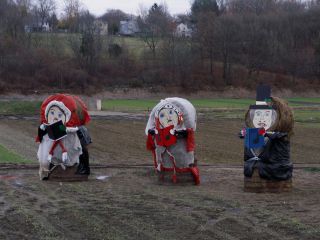
I am thankful to have so many dear friends that surround me with warmth and enthusiasm
I am thankful for having many great teachers -- not the least of whom are those that I think I am teaching
I am thankful for my smart, funny, industrious, creative family
I am thankful that I have a multitude of projects to amuse myself through my old age, and pleased to have learned enough new skills to be able to play with them.
I am thankful to be in good enough health
I am thankful to have abundance in my life
I am thankful to have discovered optimism, or at least the ability to concentrate enough to soothe my adddled brain into an optimistic place in less than ideal circumstances
I am thankful to the Bush administration and neoconservatives everywhere for providing me with less than ideal circumstances, so that I can practice optimism.
I am thankful for the awakening that is taking place in this country about the futility of war, the evils of greed, and the misuse of power
I am thankful for Ariel Sharon's change of heart/strategy
I am thankful that thieves are being prosecuted, and that an administration that has been so damaging to the earth and to mankind is being exposed to the light
I am thankful that the earth is showing us how much distress she is in, just before it's not too late to make changes in our behavior toward her.
I am thankful to have discovered the vast expansion of consciousness that the internet offers, and to be able to maneuver my machinery around enough to get to most of my intended destinations in cyberspace (and to land on such interesting unintended ones).
I am thankful to be able to laugh so much
I am thankful that since I know how to cook the turkey, I wont' have to do the dishes.
Photo note: Shot this jolly group at the farmstand after I picked up my turkey. They looked a bit like pilgrims, well, okay, pilgrims with caroling books. When it gets light, I'll try to take a photo of my mum turkey. It's jollier.
As promised. This was a gift. An example of something better shot than manifested.

November 22, 2005
Avian Flu is Still Looming
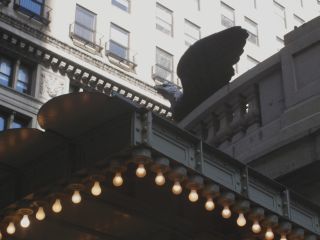
Even though I haven't been beating you over the head with avian flu awareness facts for the past few days (though I have been known to brush lightly upon the subject ), I can no longer shirk my civic responsibility.
Let's just say the news isn't very good. Since a picture is worth a thousand words (ask Lindy) take a peek at the changing map of identified avian flu outbreaks in the world. The damn thing just develops more and more spots.
The situation in China is unclear, but I think it could be said that it's not exactly improving. And there are new versions of H5 showing up, considerably closer to home. The national pandemic plan has made it pretty clear that the problem will be handled at a state level, and my state pandemic plan is written in anticipation of vaccine and antivirals flowing from the federal government, like wine from a carafe..
Kate Walker of UPI quotes Michael Osterholm, Director of The Center for Disease Research and Policy in her article on broad stockpiliing
"'There would be major shortages in all countries of a wide range of commodities, including ... medicines, including vaccines unrelated to the pandemic. ... Aside from medication, many countries would not have the ability to meet the surge in demand for health-care supplies [like syringes] and services that are normally taken for granted,' he said.
'Virtually every piece of medical equipment or protective gear would be in short supply within days of the recognition of a pandemic. Throughout the crisis, many of these necessities would simply be unavailable for most health-care institutions.'
Osterholm's dire warnings about U.S. dependence on international trade -- including medical supplies -- also appeared in a recent issue of Nature magazine.
'Today, we have virtually no surge capacity for any consumer product or medical service that might be needed during the 12 to 36 months of a pandemic.'
These are sobering thoughts indeed. And in the face of a media storm surrounding the production of a H5N1 vaccine and global shortages of Tamiflu, it behooves us all to take a longer-term approach, aware of the duration of a pandemic, and ensure that governments and local health-care authorities are aware of the need to stockpile non-influenza related medicines, and to ensure the continuation of global supply chains in the face of a crisis that could last years."
Guess this is the wrong place to look for soothing reassurance. (click pre-made - "That thing you're going through")
Photo note: The American Eagle atop Grand Central Station. For those of you who are interested in metaphorophotography, notice the double triangles
See the birdy?
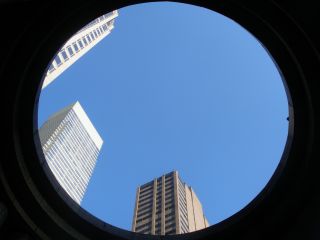
Taking an opportunity to synchronize my vibration to hypomania, as I was in New York City, and fading fast, I purchased a tall Breakfast Blend at Starbucks, and took it outside, since there was no place to sit inside, or even stand in line, for that matter.
Locating a relatively pigeon-poop-free spot on an architectural feature of the adjacent monument, I settled in to enjoy precipitating hypomania -- keeping the cover on my coffee to avoid unwanted flavoring from above.
Of course, I could not help but thinking of the avian flu, and challenged myself to shoot a few of the indigenous species flapping around me for future entires. Birds, as you may remember, move much too quickly for my digital shutter, or aperature, or something like that. I got one, though. Can you see it perched at three o'clock?
On a related, counterpuntal note, some buildings are using bird spikes to gently discourage pigeon toileting-- you can see the little fuzzy fringes above the arch and on all the possible loitering surfaces on this doorway.
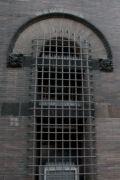
Photo note: All of the above.
November 20, 2005
Back to nature



This little collection illuminates one of my repeating dilemmas. When I shoot fifty views of something, I never know which one to publsih, especially if the subject matter isn't exactly fascinating. I couldn't decide (obviously) so I just slapped them all up.
Think of it as a refreshing sorbet, before we return to the big city.
On my way to finding clickies for "refreshing sorbet", I stumbled upon the the man of my dreams. Forget looking at my photos and enjoy him thoroughly in all his iterations, or..... get a few pointers. He goes well with the barn boards.
And while I'm publishing non sequiturs, here's a woman after my own heart --except, I'm a blonde.
November 19, 2005
New York Prepares

Back to finishing off the New York roll. Of course holiday preparations were in full swing , as it was the week before Thanksgiving. The tree at Rockefeller Center was erect but not unveiled (I will spare you that clickie) I was a little saddened this year by the thought of a tree of this size and magnificence being chopped down for frivolity. I think it's time to go artificial. Leftover trees go to the zoo in Central park as play structures for the animals.
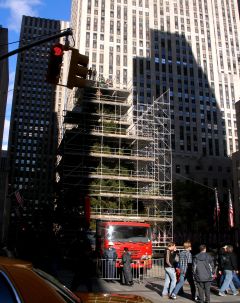
The girls are getting ready for their extravagana. Rockette Christmas Costumes can be purchased, just in case you don't have anything to wear to your own holiday celebration. I preferred the ashtray.

I bet Takashimaya, the beautiful Japanese Department Store, is ready year round, though I see they are wishing us all an urbane Christmas on their website. The floral department here was spectacular, featuring lovely little individual succulents plopped everywhere, on glass shelves, completely potless. All they require is a spritz from your Evian bottle now and then (not included). Twenty five dollars each seemed pricey at the time. Now I can't even find them on the internet, because I don't know what they're called, and catch myself longing to have one sit faithfully by my computer while I write, or cling to my bosom as live decoration at the next posh event. Oh well. Locating some will be my next manifestaton project.
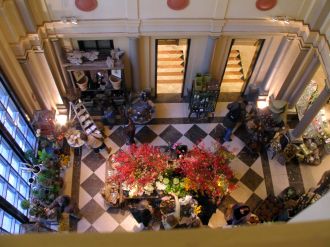
And Ralph Lauren did wonderful winter windows, perhaps inspired by the "Safe" exhibition at MoMA. Inside there was not a price tag under $425, nor an unlifted face. Most folks on the premises, and probably within a ten block radius, were wearing well over $1000 worth of clothing, and they were in their Saturday jeans.
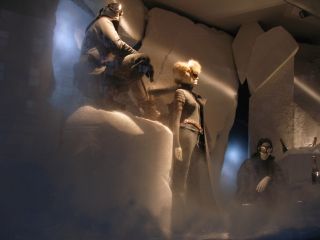
Yesterday, Peter Kramer of NPR's "The Infinite Mind", devoted the entire program to hypomania. New York was called a hypomanic city (as we are a hypomanic society -- the spectacular success of Starbucks being part of the proof, since those of us without hypomania must develop whopping caffeine habits to keep the pace.) Turns out that relatives of people with bipolar disorder are the lucky duckies. They have all the fun of being hypomanic without the raging psychosis and devastating consequences of full blown manic episodes. People suffering from hypomania are rarely seen in therapist's offices.
"Doctor, I'm divinely happy, I'm full of creative ideas, and the energy to implement them. I'm never tired, I need very little sleep. I'm excited about life. I'm fun loving and adventurous, take lots of risks and bounce back easily from failure. Can you help me?"
I'm rushing out to get "Exhuberance" Kay Redfield Jamison's new book, all about the joys of hypomania, to see if I can develop some naturally. Maybe if I just moved to New York. I don't think I should consider snorting cocaine at my advanced age.
November 18, 2005
Kissing the Laureate
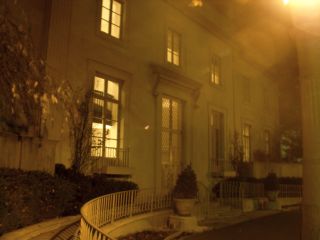
I am interrupting my New York Series, to report from a reception held at the home of the President of MIT, honoring my friend who just won the Nobel Prize.
Once again, my camera proved inadequate, but the view of Boston from the residence, is spectacular. Just pretend you are myopic and get the general idea.

I was a little hesitant to whip out my little companion, which is why I have so many shots of the powder room (awarded a AAA rating in my book). It was so commodious that, just as I finished powdering my nose and tucking my camera away, my landlord from the office, an MIT scientist himself, walked in to greet me. His wife had to remind him that he was in the Ladies' .

Upstairs the string quartet played in the living room, while we were served wine, crab cakes and Seafood Wellington in the reception area. Got the lowdown on Stockholm. Women need two gowns, one for the Nobel Banquet and one for dinner at the palace the following evening. My friend found both a red and a silver one, each with a jacket, since, like many of us who have resisted steroids, her upper arms no longer appear in public. The men, laureates and family, are provided with full regalia from the Nobel Wardrobe Room, but must bring their own black shoes. I forgot to ask about socks.
Speeches were made. The President said that, since 1990, MIT has produced nine Nobel Laureates,seven of whom began as junior faculty. She (yes, a she) attributes this to excellent foresight, and a nurturing community that supports basic research and makes folks want to stay. (In contrast, there were rumors that Harvard's Chemistry Nobel, prior to winning the prize, had lost his office and his secretary, and was being pressured to retire. Evidently, Harvard has since reconsidered.).
The Laureate himself looked dashing in a snappy new suit and a razor cut, completely ready for the media. When complimented on his remarks in the New York Times by a former reporter, he asked what he said, hoping it was the right thing. He now has trouble keeping track of what's been written about him. Life has changed.
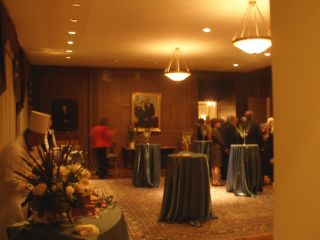
As I departed, the Laureate asked if I had ever been kissed by a Nobel Laureate. Now I have.
November 16, 2005
MoMA
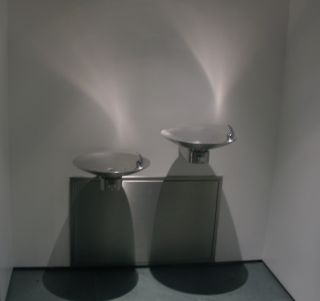
And what would a visit to NYC be without a stop at the new Museum of Modern Art? Sadly my little camera was not really up to the task, in that flash is not allowed, and I did not have my megaphone with me to shout "Freeze!" to the mob of museum goers. They inconsiderately kept moving, thus spoiling many a shot.
But enough of photographic complaints. The drinking fountains were well set, down a long, inpenetrable hall. In tamdem they made quite a lovely inanimate display -- design worthy of the setting. The bathrooms, though, were a disappointment. Fixtures, handles, dispensers were ordinary, if plentiful, pale in comparison to the drinking fountains.
The new MoMA serves the large canvas well. Vast white expanses are terrific for those artists who had the foresight to paint on canvas larger than 18 feet x 18 feet. Unfortunately, some of the more famous paintings in MoMA's permanent collection are quite a bit smaller. These too are hung on vast white expanses, in large amounts, which does nothing to enhance their uniqueness or their beauty. I would rather not look at art under the same lighting one might find in a morgue. I found myself craving intimacy.
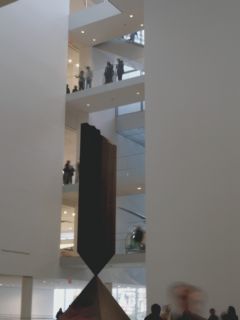
There was an astonishing photo/video exhibit featuring the work of
Michael Snow and Sam Taylor-Wood . "Still Life" , (phase 1 shown in the blurb) grows mold and disintegrates in it's very own frame. A dead hare is eaten by maggots right in the gallery-- quite remarkable. These rooms, of necessity are dark, and make viewing more pleasant.
Other delights included the Matisse ladies, staring back
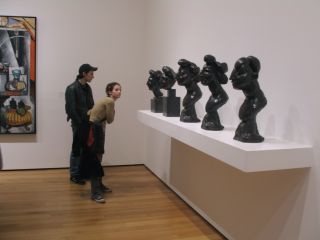
And a becapped gentleman communicating on his cellie while ladies romped.
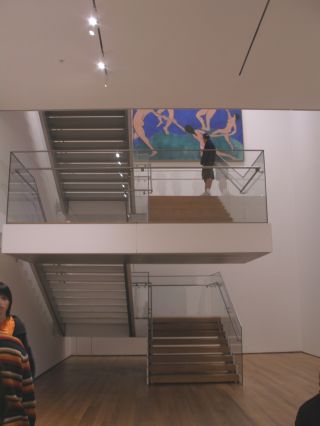
Of course, I shot Brancusi sculptures with avian flu in mind.
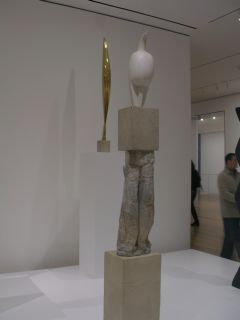
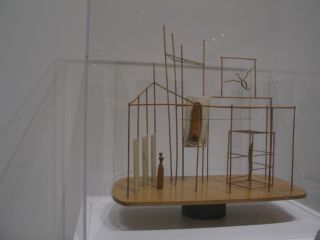
Then, with perfect synchronicity, upon mounting the summit, I discovered the exhibit entitled "Safe: Design Takes on Risk". You can see the entire slide show if you go to the audio clickie. I was pleased to see my dear 3M95N masks displayed (I am the proud owner of a case), in addition to many other handy dandy items, including an iron security fence with bladed birds atop.
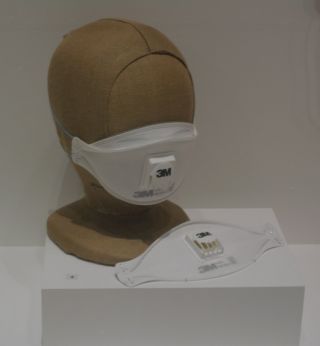
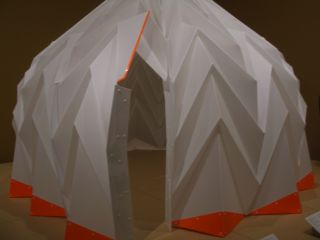
Severely overstimulated, I joined the crowd resting their weary feet, staring out the window. I would have hit The Cafe had the line been shorter than fifty, so I cannot review the snack situation, though I'm sure prices matched the $20 entrance fee.
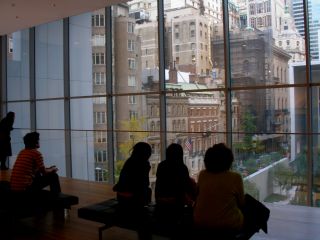
Bless them all for sitting still.
November 15, 2005
New York City, Installment 1
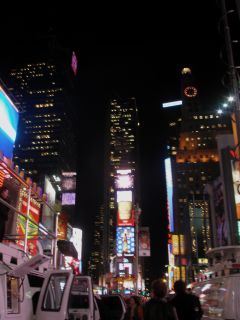
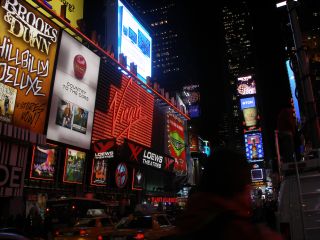
Arriving in Times Square at 2:30 AM, due to a small traffic jam in Hartford, we were somewhat slowed on 46th Street by a bicycle of sorts - actually it was a group riding a bicycle of sorts. The group made erratic progress down the street in front of us, as well as a great deal of noise. Of course, I tried to take a shot, and it turned out to be one of the many totally black frames in my New York City Series, to match my collection of totally fuzzy shots taken surreptiously without enough light.
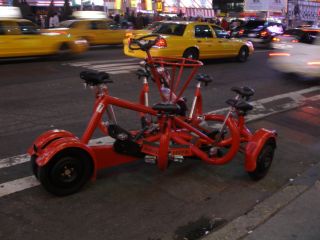
Fortunately for my readers, I later came upon the "Party Bike" unmounted, and was able to get a picture in the light of the billboards. Then, of course, like a sensible person, I looked it up on google, and saw that I could have saved myself the trouble.
The hotel was in the epicenter of Times Square, and, though the room itself was a restful haven (available for purchase in its entirety), getting upstairs required finding one's way through flashing lights, glass walls and inpenetrable glare (an indoor simulation of the exterior scene) -- definitely not the hotel of choice for those with cataracts and/or epilepsy. Below you will find a picture of one thirtieth of the glare. Can you locate the floor upon which the person is walking?
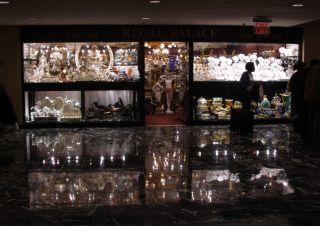
And then there was the carpeting, probably meant as counterpoint to the glare. Some demented decorator must have chosen it for its stain resistance (anticipating all those hot dogs with catsup and mustard guests would drag in from the street vendors). I will spare you the blown up version. Suffice it to say that all floor areas that were not mirrored, were covered in some heraldic iteration of pseudo Chinoise. A view from the glass atrium elevator, reveals all sixty floors of hallways are covered with same. I suppose a quiet beige would have been difficult to keep clean.
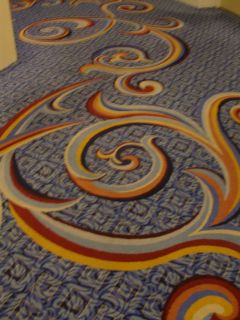
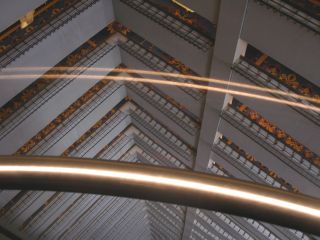
And so, exhausted and wildly overstimulated, I began my visit to New York City. Awakening at the ungodly hour of 8AM to a lovely view of Times Square.
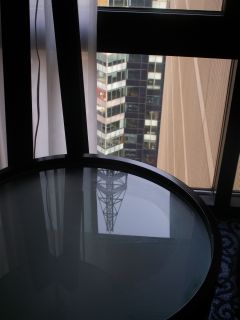
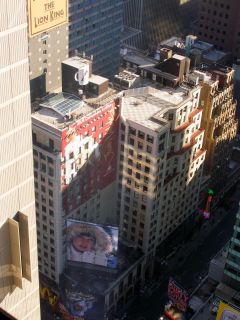
Really, for a metaphoromorphophotographer, New York can be quite overwhelming, considering the number of closely packed, shiny surfaces, covered with symbolic, architectural and human interest. I'm still tired.
November 13, 2005
Hosta Uptha Wazoo






enough
hosta
to sink
a battleship
methinks
she
has it
out of
her system
now that
it's turned
to compost
Hosta la vista

another
quiet
country
photo
to calm
me
after
my visit
to the city
November 10, 2005
A muted autumnal scene

off to the big city
this weekend
leaving behind
a classical
New England
autumnal scene
lake in fog
for your
semi permanent
enjoyment
What were they thinking?
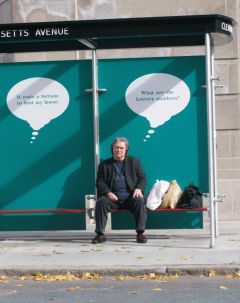
As you can see from the smaller view, this bus stop is a clever ad for The Boston Globe, which is owned by the New York Times, so I thought it a fit illustration for a celebratory salute to the resignation of Judith Miller, from the aforementioned. It's about time. I would have fired her for not checking her sources, taking dictation from the administration and warmongering at least a year ago. Just what has the New York Times been thinking?
Photo note: I was stuck in a traffic jam outside of Symphony Hall the other day (involving 200 school buses, photo later), and spotted this gentleman waiting for a bus, perfectly costumed. He's looking right at me, aiming my camera right at him, wondering what I'm thinking.

November 08, 2005
The Massachusetts Pandemic Preparedness Plan Arrives
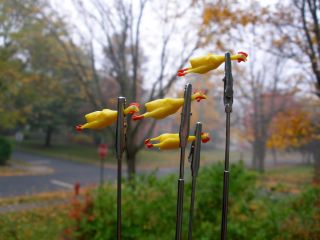
Everyone (except the rather large contingent who wish I would shut up about avian flu) will be excited to hear that The Commonwealth of Masachusetts Influenza Pandemic Preparedness Plan has arrived. This is ia welcome addition to the Commonealth of Massachusetts, Department of Public Health Influenza Web Site
Although some of you might be depending on me to read the whole damn thing, and summarize, I know that otherwise this could be a complete bore. In fact, you might just skip this entry, especially if you don't live in Massachusetts, although I'll bet that your state's plan is similar. Australia and New Zealand have done a better job.
In any case, because of time pressures, and flawed attention span, I've only taken a peek -- my preliminary impressions follow.
Complaint number one. The plan cannot be copied, except in it's entirety, for some reason. I had to download the whole document into Word Pad. Really.
The first twenty pages primarily deal with statistical gathering, documentation of flu cases, and testing to see if the virus is H5N1 or another "novel" [read killer] virus. Important, but the paper work requirements are odious and might go right out the window if medical facilities are overwhelmed, and providers are stricken themselves.
Then, on page 21, we get to the real meat -- Section 3: Vaccine Delivery begins with "Assumptions"
"1. There will be a minimum of 6-8 months between a novel virus alert and the availablity of vaccine. When the vaccine does become available it will be distributed in multiple shipments over time as it is manufactured. Vaccine shortages are likely to exist especially early during a pandemic."
The implication that we will have to wait just a little while until the vaccine begins to flow into our state, is, as far as I'm concerned, a mighty big "assumption". Most experts estimate that a vaccine will not be available until 2008-9. Every idea in Section 3 that follows assumption #1, depends upon the availabity of vaccine. We are not offered much information about what to do while we're waiting for two or three years and dying. Oh well. I think we have to throw out most of the plan after Assumption #1, if we're going to be realistic. There is acknowledgement that security might be important, should some vaccine emerge somewhere, because people might be tired of waiting and try to steal it.
Next are the "Challenges" listed in Section 4: Use of Antivirals in the Prophylaxis and Treatment of Influenza During a Pandemic.
"• Unknown how many doses of antiviral medication will be available during a pandemic" [We DO know that 2 milion doses of Tamiflu have been stockpiled by the feds, and that there are 300 million citizens in this country. We DO know that there are 14 countries ahead of us on the Roche waiting list for Tamiflu, yet to be manufactured. I'd say the citizens of Massachusetts, given their liberal leanings, should count on about thirteen doses, if that. Just enough for our Republican governor.]
"• Antivirals may be available in both the public and private sectors." [may is the operative word]
"• Oseltamivir, the antiviral drug shown to be effective against H5N1 strain of influenza is
made by a single manufacturer. Production occurs in a series of steps and takes 12 months
for raw material to the finished product. [Reach any conclusions here, folks?]
"• For treatment to be effective, it must be started within 48 hours of symptom onset." [I can't even get an appointment with the podiatrist within 48 hours, let alone the doctor and the pharmacist, both of whom, I assume, will be quite busy during a pandemic, or sick themselves]
Peter Sandman, a risk communication expert, in his excellent essay "The Flu Pandemic Preparedness Snowball" cautions:
". The focus on the pharmaceutical fix is excessively optimistic. It is keeping people from focusing enough on worst case scenarios.
. The focus on the pharmaceutical fix is excessively medical. It is keeping people from focusing enough on non-medical preparedness.
. The focus on the pharmaceutical fix is excessively governmental. It is keeping people from focusing enough on what civil society, the private sector, and individuals can do
. The focus on the pharmaceutical fix is excessively national. It is keeping people from focusing enough on local preparedness.
. The focus on the pharmaceutical fix is excessively first-world. It is keeping people from focusing enough on ways to help Africa, Asia, Latin America, and the Middle East prepare for a pandemic."
I guess the authors of the Massachusetts Plan didn't get a chance to read his article.
Photo note: A metaphorophoto of sorts, for your amusement, just in case you don't live in Massachusetts..
November 07, 2005
More Poms

On Friday,in my role as bird flu supply officer, I visited a nearby grocery store known for its bargains, crowds and international marketplace ambience. Much of its popularity rests on the fact that one can still purchase three items for a dollar, most of which come in a can, or are dried and need soaking overnite - ideal for my purposes. Saris shalwar kameez, dashikis, head scarves and nun outfits abound. If I were a portrait photographer, I would station myself on a bench outside, or in the produce aisle and shoot to my heart's content. Portrait photography, however, and shyness are a poor combination. At least in this store, they are not display proud, and photos seem to be allowed. The smarmier markets do photography patrols, lest their luscious display techniques be stolen by visual thieves, like yours truly, who will instruct the competition how to stack produce artfully.
I had just discovered this single pomegranate nestled among the dried peas, when the Giant Pomegranate Sale was announced over the loudspeaker.. You guessed it, I couldn't decide whether there is pomegranate season, and I had landed smack in the middle of it, or the universe was sending me a message about what I should be ingesting.
Since I still had an abundant supply of the fresh poms at home, I bought three bottles of Pom, The Juice. I found it a bit sour, A friend reminded me that a splash of vodka improves most drinks (well, maybe not their health quotient), so I made pomegranate martinis which were rejected outright by some, and which I found barely palatable.
FYO at the fancy market today, which is less than two miles away, there were only six pomegranates to be found, each priced at a hefty $2.98. One pays such a premium for pretty stacking.
Photo note: See above and below. Regretfully there were no exotic costumes passing by.

At the Garage Sale
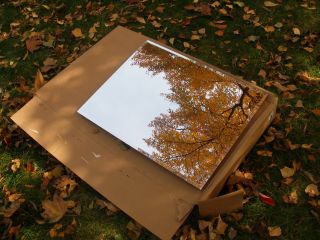
Sometimes
the best
pieces
at a yard sale
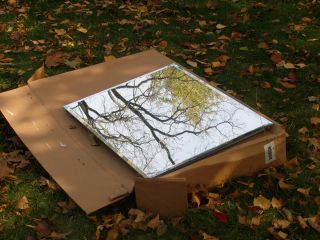
are not for sale
but free
and fleeting
immaterial
priceless
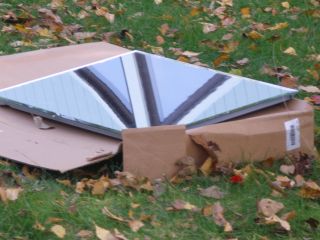
best left
behind
when
thoroughly
shot
only to clutter
the hard drive
November 04, 2005
crocus in the hosta

It seems that social connection and social networks are very important for the creation, support and enrichment of thought and ideas. Sadly the Christian Fundamentalists seem to have the social connection part down pat, with their church suppers, prayer breakfasts and phone trees . Maybe that's one of the reasons they wield such a powerful influence in our culture, and their numbers are growing. They are certainly creating and proffering THEIR ideas effectively. The rest of us better get busy.
An essay and an interview, both of which I stumbled upon within the past few days, have illuminated the importance of social connection (and it's demise) in the creative process.
Michael Nielson, a theoretical physicist from the University of Queensland wrote a short essay entitled "Extreme Thinking", in which he offers young scientists the advice he wishes he had had as a beginner. I hope you will read the entire piece and pass it along, (which I did, and am doing -- twelve points for a mildly improved attention span). Here's a summary of his three principles, for those of you who are pressed for either time or attention.
"The first is that effective learning requires purpose and meaning. This purpose and meaning can, in many instances, be obtained by concentrated self-development focused on developing combinations of abilities that enable us to make a unique contribution.
The second is that effective learning requires a long-term vision. In all organizations the short-term incentives neglect critical aspects of our development. By developing and constantly reinventing a compelling long-term vision we are able to ensure that we develop and learn in the most effective ways possible, even when those ways are in contradiction to the established short-term incentives.
The third principle is that one of the most effective ways of changing deeply ingrained habits and establishing new behaviour is to create a social environment that will promote the behaviour we’re trying to learn."
Do not underestimate the social thing -- Nielsen describes the collapse of cooperative learning situations he's tried to create, simply because of his inabliity to manage the social issues involved. Thomas Kuhn, scientific philosopher and historian, has written a great deal about the importance of social environment in the acceptance of new scientific discoveries.
Some of you may remember that my friend just won the Nobel Prize for chemistry . An official at MIT has said that he couldn't have done his research today, because it was too basic to be funded, and did not have an immediate practical application. His passion certainly played a part in his research. In a newpaper interview, he said that his interest in chemistry began with a chemistry set given to him by his older brother. At the beginning, he was fascinated by explosions, but has refined his passions somewhat over the years. "I like to cook, I like to do woodworking, I like to manipulate molecules." He's a good example of Nielson's principles. He's a pretty social guy too.
Then, early this morning on the BBC I heard an interview with Robert Putnam, Harvard political scientist and author of "Bowling Alone", his study of the demise of social networks in the United States Amazon says:
"Few people outside certain scholarly circles had heard the name Robert D. Putnam before 1995. But then this self-described "obscure academic" hit a nerve with a journal article called "Bowling Alone." Suddenly he found himself invited to Camp David, his picture in People magazine, and his thesis at the center of a raging debate. In a nutshell, he argued that civil society was breaking down as Americans became more disconnected from their families, neighbors, communities, and the republic itself. The organizations that gave life to democracy were fraying. Bowling became his driving metaphor. Years ago, he wrote, thousands of people belonged to bowling leagues. Today, however, they're more likely to bowl alone:
Television, two-career families, suburban sprawl, generational changes in values--these and other changes in American society have meant that fewer and fewer of us find that the League of Women Voters, or the United Way, or the Shriners, or the monthly bridge club, or even a Sunday picnic with friends fits the way we have come to live. Our growing social-capital deficit threatens educational performance, safe neighborhoods, equitable tax collection, democratic responsiveness, everyday honesty, and even our health and happiness."
Putnam came down especially hard on TV viewing (exception: public interest programs) as a negative influence on social interchange, saying that we'd rather watch "Friends" than be friends. I actually remember when everyone on the block gathered in front of the one neighborhood television to watch Milton Berle on Tuesday night, Ed Sullivan on Sunday, and the McCarthy Hearings.
As to my personal social network, I do have a small number of study, professional and social groups to which I belong, and in which I actively participate, in addition to those to which I belong and don't, like the League of Women Voters, NOW and the ACLU. Let me not forget my on-line Avian Flu Activities.
I also delude myself into thinking that there is a cozy little cluster of folks to whom I pontificate on this blog, encouraging me to write regularly, think a little bit, take pictures, and pay attention. Given the number of comments I have received in the past few weeks, that is probably a complete fabrication, but it certainly helps me with consistency in my pursuit of ..... what is it I'm doing here anyway?
Photo note: A single November crocus, isolated in a bed of dying hosta -- out of place, blooming well before its time, all by itself. Metaphoraphotographic material, if I ever saw it.
November 03, 2005
Necker Cube
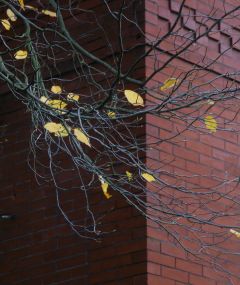
I originally took this photo as a bit of a complaint about the sparsity of brilliant autumnal foliage this year. When I showed it to a friend, she told me it was a necker cube. Not exactly an entire necker cube, but, as you view the photograph, you may have a bit of trouble telling if the corner is facing away from you or toward you. It's hard to know what's real. Some would say the ability to see it both ways is important.
I suspect that Bill Clinton, whose intellect and ideals I admire, and whose psychopathology (as far as presidential types go) I find rather touching, is one of those folks who believe in dialectical thinking. Dialectical thinking is a higher form of post-formal thought that involves understanding an opposing point of view, even if you do not share it, and trying to incorporate it into yours. Although Clinton had the best intentions, his dedication to dialectical thinking made him appear to sacrifice priniciples, and in my opinion, was most detrimental to the liberal democratic party. In an attempt to incorporate neoconservative ideas, democrats moved way too far to the right, for my taste, trying to find ways to tolerate the immorality and injustices brought to them. Bill and Hillary still have trouble calling George W. the names he deserves to be called.
I personally, am not going to go out of my way to embrace the positive aspects of racism, sexism, elitism, and privilege due to birth. To me, it smacks of welcoming Hitler's good ideas with open arms. As they say, the trains did run on time in Nazi Germany. We dont' even have support for Amtrak in this administration. Paris Hilton must be thrilled, assuming she has the capacity to understand the advantages the "Death Tax" showers on her .
I have such difficulty understanding how intelligent, well educated men like John Roberts and Samuel Alito can possibly think that their views will make a better world for everyone. Maybe they just want a better world for themselves, (and Paris H.). They must be planning to live in gated communities and hire bodyguards.
As to viewing this photo, keep in mind that, in this case, the reality is that the corner of the building is facing you, even though you can get your mind to view it the other way
Here are a slew of illusions for your perusal. Don't miss Dr Angry and Mr. Smile
Pomegranate
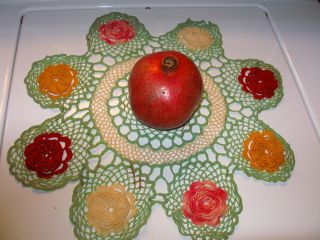
housewifely
composition
atop appliance
doilie discovered
in basement
during purge
soiled, but intact
kitchy geometry
elusive meaning
perfect
to display
one
of six
fruity gifts
waiting
to be sacrificed
for higher purpose.
Photo note: think this could pass as a sloppy eight-pointed star, symbol of fullness and regeneration? If so, it's perfectly paired with the pomegranate, symbol of womanhood. The doilie was in a box full of dusty plastic flowers purchased long ago at a yard sale for the purpose of an art project (not mine either). If I don't find a proper place for the it, it might become a permanent washing machine doilie. Cozy up the laundry room some.
